Ninth generation of video cards from Nvidia was born in early 2008. The center of attention will be the chipset of the middle price category - GeForce 9600 GT. Characteristics, test results, general impression of stability of work - all this you can find below. As a result, you can determine the choice of a budget video card.
History of appearance
In 2008, when AMD was busy with the release of budget video cards, Nvidia only had copies of the top-end version. Thus, they deprived themselves of the largest segment of consumers. The question arose about creating a competitor for the Radeon 3800 Series. The first thing to try to occupy this niche with a weaker version of the top-end GeForce 8800 graphics card was reduced to ridiculous 256 MB. And the board was released for sale. However, among PC users this modification of the video card has not gained popularity.
The profit from sales was negligible. All because the cost of such a top chip is high enough to cut its performance and sell at a low price. As a result, the ninth series came to the fore. Initially, production was planned to begin no earlier than a year later. In particular, this refers to the first GT. The characteristics of the video card are at an average level: between 8600 and 8800 GTS. From the AMD range, the 3800 series became a competitor.

The motto for increasing sales of 9600 GT was the following phrase: good performance for small money. From the review, you'll find out whether the statement was confirmed or not about the Nvidia 9600 GT video card, the characteristics of which are impressive. This graphic chip has become a real founder of a whole generation of new chipsets that have brought even greater popularity to the company and significantly expanded the customer base both among customers of iron hi-end class and in the middle price segment.
Nvidia 9600 GT: specifications
So, let's see what the video card is like. The basis for it was the 8800 GTS chipset. Only trimmed by parameters. Since the 8800 GTS was just an interim development, the technology of which was used later in 9800. The base for the card was the G94 chipset, the same as in the 8800 series. You ask: why then it is much cheaper and what saves the manufacturer? The answer is quite simple. The 9600 GT cuts the number of streaming processes by half, compared to the older model. This allowed to significantly reduce the price. But the increase in performance was achieved due to the use of identical tires with a bit width of 256 bits. This allowed us to achieve higher CPU and shader processing rates.

According to the manufacturer, the video card 9600 GT, whose characteristics are truncated, is more productive than the 8800 series by as much as 15%. That's a breakthrough in technology! A little later we will determine in practice tests whether this is true or not. Also, the video card is equipped with 512 MB of internal memory, support for SLI mode (simultaneous connection to the system of up to three identical video cards running in parallel). It has a DirectX 10 interface and all the necessary connectors for connecting monitors, outputting images to a TV and so on.
External review of the video card
The board was slightly smaller than its predecessor, mainly due to the simplification of technology. This allows you to install it in a fairly tight budget building. After all, the 9600 GT (the characteristics of the middle-end level) should match its class, whatever one may say. Throughout the board area there are a number of holes that are designed to improve heat transfer. From the top it is closed by a plastic casing with a radiator and one cooler. This is sufficient to maintain a stable low temperature even at high loads.
Test results
For the tests in the games the following stand was installed. Process from Intel - Core 2 Duo, dual-core with a frequency of 3 Hz per core. In addition, 4 GB were available random access memory, hDD volume 750 GB and power supply Acbel for 500 watts. The testing was carried out in those games that were relevant at the time of release of the 9600 GT. The characteristics of the bench computer also correspond to that time.
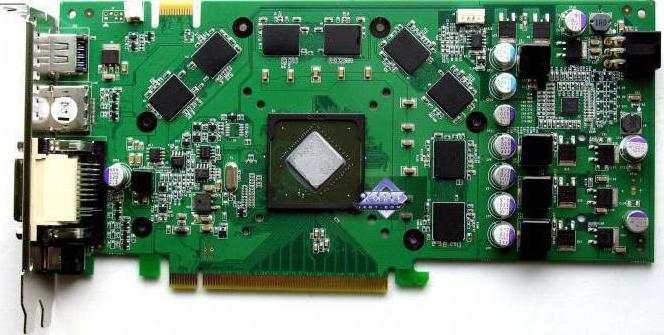
Based on the performance in the games Crysis, Call of Duty 4, Bioshock, Lost Planet. All of them were launched with support for DirectX 10 and at the maximum settings with Full-HD resolution. The first game (Crysis) behaved very badly - only 10 frames per second. Affects the budget of the model of the video card. In Call of Duty 4 and Bioshock, the game produces stable 40 frames per second at the maximum settings. This is already good for the average price segment of video chips. In Lost Planet it was comfortable to play on medium or low settings with the maximum screen resolution.
Power Consumption and Overclocking
Let's move on to power consumption. Engineers of Nvidia have managed to reduce power consumption by as much as 15%. Creators show by all means belonging to the middle class video card Nvidia 9600 GT: characteristics, power consumption, performance are exactly on good level for their price. Do not forget the creators of the video card and about the amateur experiment on his iron. Overclocking options decided not to touch. Therefore, at their own risk, owners can try to create from a board with an average performance of a real monster and conqueror of modern games.
The GeForce 9600GT family came to replace the GeForce 8600, but despite being an average price range, it can compete with more expensive GeForce 8800GT video cards. Apparently, that's why the new video card was attributed to the generation of GeForce 9, because you will agree, it would be rather strange if the "middle peasant" could compete with more expensive colleagues within the same family. In addition, the eighth family already has a GeForce 8800GT, which formally is also a solution of the average price range, and the new GeForce 9600GT fits perfectly into the middle of the ninth family in terms of speed and does not "interfere" with the old people. But let's go directly to the technical characteristics of video cards, and the task of positioning them in the market will leave marketers. After all, the phrase "I have a video card of the average price range" is not full! So, despite the fact that the GeForce 9600GT belongs to a newer generation of video cards, it brought nothing new, except for the Display Port interface. The new G94 graphics processor is based on the same architecture as the older G92 chip, and differs from it with fewer functional blocks and slightly larger nominal clock speeds. However, judge for yourself:
|
Name of the characteristic |
||||
|
Graphics Processing Unit (GPU) |
||||
|
Amount of video memory, Mb |
||||
|
Memory bus width, bit |
||||
|
Frequency of core / shader unit GPU, MHz |
||||
|
Effective frequency of video memory, MHz |
||||
|
Number of universal processors |
||||
|
Number of texture units |
||||
|
System bus and other communication interfaces |
PCI-Express 2.0 x16 / 2xDVI / HDMI / Display Port / S-Video |
PCI-Express 2.0 x16 / 2xDVI / HDMI / S-Video |
||
Judging by the numbers, the novelty should be one and a half times slower than the GeForce 8800GT, however our today's testing will show that this is not so. The reason for this is a good balance of the number of functional units of the new G94 graphics processor. But let's move from theory to practice.
The novelty meets us with the image of a girl who already figured earlier on the packages of video cards from Chaintech. To the right of the girl's image there are key characteristics of the video card, for example, the amount of video memory and supported interfaces.
The reverse side of the box is not replete with any useful information, except that newcomers will be able to learn what SLI technology is.
The video card package includes the following:
- adapter for powering PCI-Express cards;
- s-video adapter\u003e component out;
- connecting cable for S-video;
- dVI\u003e D-sub adapter;
- CD with drivers;
- a brief instruction for installing a video card.
Externally, the novelty as two drops of water is similar to the GeForce 8800GT, only minor elements and, in fact, marking out a different video card in it. Note that the Cahintech 9600GT is made using a reference design from NVIDIA.
But the reverse side of the video card is no longer so similar to that of the GeForce 8800GT. The left side of the board is noticeably thinner in terms of radio elements. Such simplifications are quite logical, because the novelty should be inexpensive, and due to the simplification of the graphics chip, the requirements for circuitry also decreased.
Having exposed the video card, we again become witnesses to simplifications. So, the wiring of the power subsystem initially provides only two phases, in contrast to the GeForce 8800GT card, but more about this later. In the meantime, let's talk about the cooling system. To make contact with the graphics processor, a heat-conducting paste of gray color is used, and for contact with the rest of the elements a cloth impregnated with a white heat-conducting paste is used. In general, everything is as usual.
Like the GeForce 8800GT, the cooling system of the new video card is made of aluminum (more precisely - its alloys) and is equipped with a copper insert, designed to remove heat from the graphics chip.
The quality of processing the copper pad is good, but not more.
Under the casing of the cooling system, there are three flattened heat pipes, on which are attached aluminum plates, which, in turn, are blown by the fan. Unfortunately, hot air is not blown out of the computer case, which is a drawback. But the cooling system has obvious advantages: it is compact due to the "one-storey" cooling system. And given the low heat dissipation of the new graphics chip G94, we can well expect from our "baby" good results. But more on that later.
The reverse side of the video card is more noticeably different from that of the GeForce 8800GT: as we have already said, the GeForce 9600GT PCB means two-phase power to the GPU, unlike the GeForce 8800GT, whose printed circuit board provides three-phase power. For the sake of fairness, we note that the GeForce 8800GT has only two phases implemented, and the third place is reserved for building more expensive GeForce 8800GTS 512, so in practice the new GeForce 9600GT is no worse than the more expensive colleague. Also pay attention to the left side of the board, where too, there have been changes. But, again, given that the GeForce 8800GT had only a contact pad for the video capture chip, which almost never broke apart, this change simplified the design of the PCB and lowered its cost without worsening, and perhaps even improving its stability work. After all, complications often negatively affect the quality of the work of various electronic circuits.
The GPU of the GPU is rotated relative to its normal location. A similar arrangement of the crystal has already been used in the Radeon HD2900 video card, then the developers talked about simplifying wiring to increase stability. Apparently, this is what caused the change in the orientation of the crystal in the G94 chip. Next to the graphics chip are located a semicircle of eight video memory chips, forming a total volume of 512 MB. By the way, the G94 chip belongs to the first revision.
The chips are manufactured by Samsung and have a sampling time of 1 ns, which corresponds to an effective frequency of 2000 MHz.
Cooling system efficiency and overclocking
Despite the fact that we have already got acquainted with such a cooling system installed on the GeForce 9600GT, according to the previous results, we can not judge new video card. Why? Yes, it's very simple - a new graphics chip is warming less, and, consequently, the requirements for a cooling system are also smaller. But from words to deeds. To check the quality of the cooling system, we will, as before, with the help of the Oblivion game, tuned to the maximum quality, and the program Riva Tuner 2.07, which our creator, Alexey Nikolaychuk, kindly shared with us.After 11 minutes of running the game, the temperature rose from 45 to 61 degrees. Very good, especially considering that for the "old woman" GeForce 8800GT the values of about 75 and above degrees were the norm. The novelty from Chaintech also did not disappoint with the overclocking. With a staff of 650/1600 MHz for the graphics processor and 1800 MHz for video memory, it stably worked at frequencies of 780/2000 MHz for the graphics processor and 2200 MHz for the video memory. Particularly we emphasize that we did not resort to tricks like increasing the speed of the fan rotation, however, in a domestic environment it still has to be done, for example, with a slow 120 mm fan on the side of the video card. After all, we tested the video card in an open case, which, of course, favored its cooling. Well, let's move on to the next participant of our testing.
The GeForce 9600 is an average price segment video card from the California company Nvidia. In this article we will analyze all the pros and cons of this chip, find out whether its cost is justified, and also conduct some tests that will help determine the performance and stability of the chipset.
How did the map appear?
In 2008, AMD Company presented a series of 3800, which occupied the niche of video cards of the middle-end. For a small price, the buyer received excellent performance. In this category AMD did not have a competitor. Nvidia thought about creating a mid-price video card with good performance, in order to discourage part of the market from a competitive company.
The attempt to leave on the weakened flagship 8800 GT failed due to the reduction of video memory. The cost price of such cards is quite high, which in the end gave too little profit from one video card.
The engineers of the company decided to create the perfect new platform G94, on which the GeForce 9600 was created. Let's see if the decision of the company is justified, or did Nvidia deceive themselves, as in the case of the "light" 8800? To get started, let's get acquainted with the characteristics.
GeForce 9600: Features
The basis for the video card is the new architecture G94, which is the direct heir of the 8800 series platform. According to the architecture, this chipset is between the average 8600 and the higher 8800. The number of stream processors is more than twice that of the first, but less than the second.
The new technology allowed to keep the bit width of 256 bits and thus leave the performance at a good level. According to the characteristics of the video card is hardly inferior to the flagship. Its throughput is increased by 15% compared to the previous generation. The simplification of architecture allowed to save on the production of a video card.

The GeForce 9600 supports all known interfaces that were relevant at the time of the board's release. DirectX9 and DirectX10 are also present. The card is connected to the motherboard via an absolutely standard PCI Express 16 connector. The number of internal memory is 512 MB. 9600 is updated to this day, and the video card supports the most latest versions, which is a big plus for the owners of these cards.
Completion of video card
The standard version of the chipset includes a completely normal set of everything you need. In addition to the card itself, in the box you will find adapters for various interfaces, a CD with drivers, instructions and a warranty card on the GeForce 9600 GT. Feedback about the video card is very positive. For modest money, no one required a rich bundle for this "iron".
Appearance
For its price, the hardware of the video card looks rather rich. A small board has cooling in the form of one cooler and a radiator. From above all this is covered with a plastic casing. Looks expensive and stylish. One question remains: how will GeForce 9600 behave in practice?
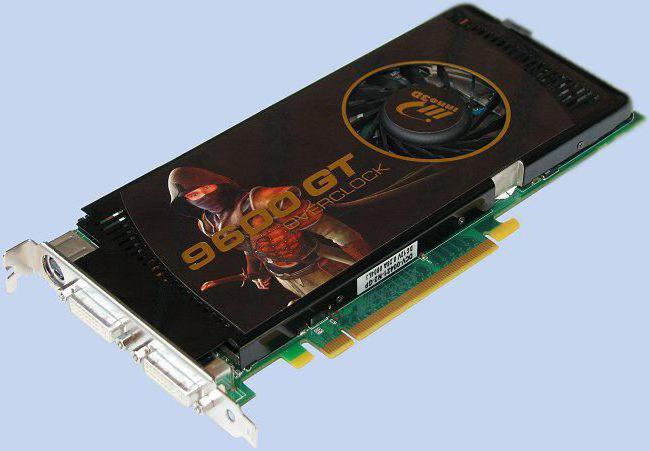
Testing and results
To conduct tests in the application 3DMark and relevant at the time the games was assembled test stand with a special configuration. The basis was taken from the company MSI, which will withstand the most serious load during testing. The processor from Intel (Core 2 Duo dual-core with a frequency of 2.9 GHz per core) was also chosen not casually for testing the GeForce 9600 GT. Reviews say that video cards from Nvidia open their potential 100% with Intel processors, not AMD. The power supply in the computer is set to 750 watts.
Competitors
Compare our subject with two competitive video cards from AMD. This HD 3850 and 3870. Both boards are in the price category up to $ 200. All 3 video cards are built on roughly the same architecture, each of them is 512 MB.
The first test was the application 3DMArk. In it, the tested video card is slightly inferior to the competitor HD 3870, but it keeps at the same level with the video card 3850. Next are the tests in the games, topical in 2008 - Prey, Crysis, Company of Heroes and classic Serious Sam 2. 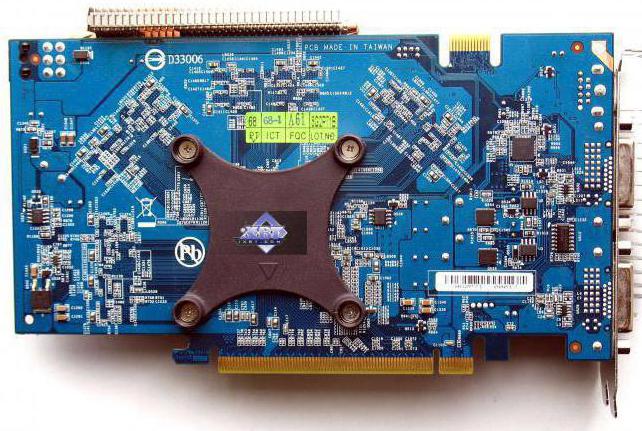
The first two games are a real test for most video cards. Prey, surprisingly, behaved very vigorously on all the video cards that participate in the testing. FPS did not fall at the maximum settings and less than 150-160 frames per second.
Crysis is a stretch, but still does not slow down. All video cards produce stable 30 frames per second, which is quite enough for a comfortable game. However, to do this, you need to slightly reduce the settings or make a smaller resolution. The video card from AMD (HD 3870) shows itself a little better - about 5-10 frames per second.
The next test is the Company of Heroes. Quite a demanding game, which requires a lot of hardware resources of the computer. Video cards do it only on average settings. On the maximum schedule the program gives out non-winning 15-20 frames per second. 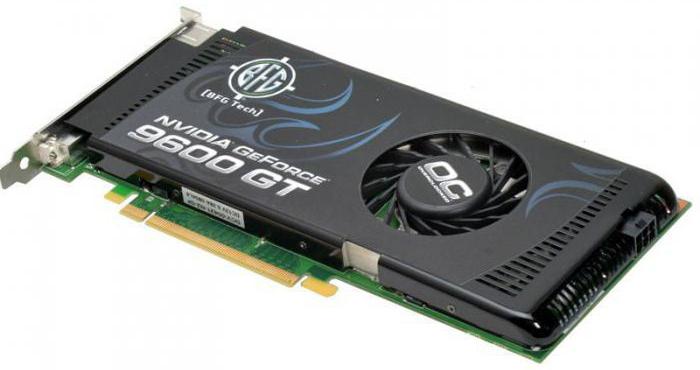
Let's move on to Serious Sam 2. Ironically, in this game geForce graphics card 9600 bypasses the performance of competitors from AMD by about 20-25 frames per second. However, all representatives issue more than 100 FBS, so the difference does not play any role. Recall that all tests were conducted on operating system Windows Vista specifically to support the DirectX10 interface. If you use the video card on DirectX9, the results will be even better and higher. All the same, this mid-range video card is not suitable for full-fledged deployment of DirectX10 capabilities in the most top-end games.
Verdict
The GeForce 9600 GT video card is a great option for those who want to try all the charms of DirectX10 on their hardware and do not pay huge money for top-end chipsets. For ordinary users who did not chase for better performance, this option was inferior to competitors from AMD. Their video cards cost $ 20-30 less, but they gave exactly the same performance as the 9600 GT. Engineers from Nvidia have developed this graphics card only for monetary benefit, and not for the development of the model series. This can be seen in obsolete technologies and reduced parameters for lowering prices and artificial conquest of the middle segment.
February 21, 208 the Canadian company officially introduced the 9600 GT video card. It was designed to send 8600 GTS in the middle-end segment in the price category to 0. The new G94 core differs from its older brother G92 only in quantitative characteristics, and the functional purpose and principle of the action of the executive units remained without any problems, no significant changes. In terms of quantitative characteristics, the 9600 GT has 64 universal processors in stock - it is twice as large as that of the "old" 8600 GTS, and half as much as the GeForce 8800 GTS (G92) or GeForce 8800 GTX. This time, let's hope that there will not be such a huge gap in performance compared to older solutions, as it was between 8800 and 8600.
So, the newly made G94 core consists of 505 million transistors (for comparison: the G86 had 210 million, G92 had 754 million, and the G80 had 681 million). It operates at a nominal frequency of 650 MHz for NVIDIA GeForce 9600 GTS. The graphics processor uses a unified shader architecture, which excellently proved itself in the G80 / 84/92 chips. The idea of unifying the functional blocks of the GPU is as follows: previously they were divided into vertex and shader, and now universal blocks are able to handle any kind of instructions without significant loss in performance. This will dynamically change the performance of the kernel by redistributing resources for the task at the moment. As a result, we get a full load of the chip, and as a result, increases performance.
In the case of G94, we see an elementary reduction - 4 shader blocks, in each of which 16 stream processors (Streaming Processor) and 8 texture units (TMU) are concentrated. In total, there are 64 stream processors and 32 texture modules. All processors G94, as in the previous chips, work with higher clock speeds relative to GPU. In particular, for 9600 GT it is equal to 1650 MHz. Finally, note the recording blocks in the frame buffer (ROP), which in this case 4 (in the diagram, the blue blocks next to the L2 cache). In the work and concept of building stream processors (SP), NVIDIA did not make any corrections since the G84 chips.
For every four stream processors, there are two TA addressing modules and two TF texture filtering modules. Therefore, now each texture unit can handle twice as many samples as the number of calculated texture addresses, compared to, for example, the G80. Each shader unit is provided with its own L1 cache. It can store not only textures, but also in connection with the unification of the blocks themselves of various kinds of data. All the stream processors (SPs) on which the G94 architecture is based are scalar. Why not vector? The reason lies in the fact that on the basis of shader software research, the developers of NVIDIA have found out that the vector architecture uses the computational resources quite uneconomically when processing complex instructions-for example, scalar and vector ones-at the same time (generally speaking, scalar calculations on vector processors are very inefficient ). In light of the recent trend towards an ever-increasing transition from vector computing to scalar, the strategy of NVIDIA developers is perhaps becoming clear. Well, what about the vector code? Everything is very simple: it is transformed into scalar operations directly by the G94 chip itself. As already mentioned, the GeForce 9600 has 4 blocks in the frame buffer (ROP). They have not undergone any changes with respect to the G92 architecture and support the following anti-aliasing methods: multisampling, supersampling and adaptive antialiasing.
Features of NVIDIA GeForce 9600 GT
| Name | GeForce 9600 GT |
| Core | G94 (D9P) |
| Process technology (μm) | 0.065 |
| Transistors (million) | 505 |
| Kernel frequency | 650 |
| Memory frequency (DDR) | 900 |
| Bus and memory type | GDDR3 256-bit |
| CAP (Gb / s) | 57.60 |
| Unified shader units | 64 |
| Frequency of unified shader units | 1625 |
| TMU on the conveyor | 32 |
| ROP | 16 |
| Shaders Model | 4.0 |
| Fill Rate (Mpix / s) | 10400 |
| Fill Rate (Mtex / s) | 20800 |
| DirectX | 10.0 |
| Memory | 512/1024 |
| Interface | PCI-E 2.0 |
The predominance of high-performance solutions in the segment is good, but the majority of video cards are sold in another segment, which is called "mass". It is usually said that this niche covers a range of offers ranging in price from $ 149 to $ 249 and should provide the buyer with something alternative, not the most productive, but at an affordable price acceptable in all modern games. Not so long ago in this niche the video cards on the GeForce 8600GTS were quite good, maybe not as fast as they wanted, being only a small part of the flagship GeForce 8800GTX, but in many respects superior to AMD's offers in the person ATI Radeon HD2600XT. But after the competitor released new accelerators series Radeon HD3800 and the gradual decline in prices for them, the alignment of forces has changed and it was required to look for a way out, i.e. to create equal or superior opportunities.
|
NVIDIA GeForce 8800 GS 384Mb |
NVIDIA GeForce 9600 GT 512Mb |
NVIDIA GeForce 8800 GT 512Mb |
ATI Radeon HD 3870 512Mb |
ATI Radeon HD 3850 256Mb |
|
|
Transistors, mln. |
|||||
|
Process technology, nm |
|||||
|
Core frequency, MHz |
|||||
|
Stream Processors |
|||||
|
Shader unit frequency, MHz |
|||||
|
Texture Mapping Units (TMU) and / or Texture Filtering (TF) |
|||||
|
Raster Operator units (ROP) |
|||||
|
Frequency (type) of memory, MHz |
|||||
|
Memory bus, bit |
|||||
|
Memory bandwidth, Gb / s |
|||||
|
Interface |
PCIe ver 2.0 x16 |
PCIe ver 2.0 x16 |
PCIe ver 2.0 x16 |
PCIe ver 2.0 x16 |
PCIe ver 2.0 x16 |
|
Multi GPU Support |
|||||
|
HDCP support |
|||||
|
Power consumption, (W) W |
|||||
The first step towards the restoration of leadership in the mass segment was the release of GeForce 8800GS, whose performance we researched quite recently. But this graphics processor only became a good competitor, both in terms of cost and in terms of capabilities, for the Radeon HD3850. It was hard to compete with the Radeon HD3870, due to noticeable architectural "cuts", such as reducing the number of execution units, and most importantly the amount of video memory and the width of the bus access to it. And with the help of the GeForce 8800GT it was hard to compete with the Radeon HD3870 - 512 MB version, of course, is more productive, but much more expensive, and 256 MB in hard tasks lacks video memory and it loses in them. This is the state of affairs that led to the release of a new graphics processor, which should be both more cost-effective and cost-effective.
What is so revolutionary about the G94-300 (D9P on new system names) that this graphics processor was the first-born of the new 9-series GPU from NVIDIA? To begin with, the further "processing" of the G92 chip has lost its meaning - disabling an even greater number of execution units will make it even slower at an unchanged production cost, and a return to the deactivated blocks will return the performance of the GeForce 8800 GT level with, again, its high enough cost . In this situation, the only solution is to make a new chip that has an initially smaller number of elements and, accordingly, a smaller area of the crystal, which will reduce the cost and power consumption, and will create the ground for further improvement of the architecture and increase of operating frequencies. And everything would be fine, even there is a "niche of names" for it, you can use an unoccupied GeForce 8700, but then there is one problem - the new chip is designed as a competitor to the Radeon HD3870, i.e. it should be faster than the GeForce 8800GS. And this leads to a conflict of models in the series. The only solution is GeForce 9 Series.
Thus, GeForce appeared not so much due to any revolutionary architectural innovations, but more as a forced marketing step, which provides an opportunity for all future innovations to give logical names, in accordance with the level of performance. Therefore, the GeForce 9600 GT is more like the "mainstream" of the previous generation GeForce 8600GTS, which doubled the number of execution units than the "stripped down" GeForce 8800GT.
The diagram G94 (GeForce 9600 Series), iXBT.com
On the other hand, not only the increase in the number of execution units is distinguished by the GeForce 9-series GPUs from the 8th. So, in comparison with GeForce 8600, first of all, the production process technology was changed - now 65 nm. In addition, finally in mass video cards appeared 256-bit memory bus, which, together with 512 MB of video memory will be very handy, when you run modern games. But there are changes in comparison with GeForce 8800GT / GS (NVIDIA G92):
In the block of raster operations ( ROP) the technology of compression of the color information which now became 15% more efficient. This to some extent makes the new architecture more productive, although quite a bit - according to various estimates, no more than 5% at equal frequencies under equal conditions. In fact, this is the only noticeable architectural change that is associated with improving performance in the GPU nodes.
Added "native" support The newest interface for connecting monitors DisplayPort. Now this output can be implemented without any additional transmitters, but due to the rare prevalence of this interface, most video cards will be equipped with the usual Dual-Link DVI-I, and DisplayPort can be obtained using an adapter.
When several GeForce accelerators are combined into an SLI configuration, new motherboards with NVIDA chipsets will appear support technologies HybridPower, which will manage the power consumption of the entire video system, up to a complete shutdown of video cards that are not used at the moment.
The output of GeForce has also been modified PureVideo HD, but they are not hardware, but are the finalization of drivers ForceWare 174.xx, so they will be supported by other chips (G84 / G92). There were: two-stream decoding, which can be useful when viewing some Blu-Ray discs; dynamic change in contrast and color saturation; possibility without disabling the hardware acceleration of viewing video in the window mode of the Aero interface under Windows Vista.
GV-NX96T512H
The first video card on GeForce, which came to us for testing, was an offer from the model number GV-NX96T512H. This graphics card does not differ from the reference labels except that it makes it a very good option for getting acquainted with the novelty.

To begin with, we give a brief description of the video card:
| Model | GV-NX96T512H |
| Graphical core | NVIDIA GeForce 9600 GT (G94-300) |
| Conveyor | 64 standardized |
| Supported APIs | DirectX 10.0 OpenGL 2.0 |
| Core frequency (shader domain), MHz | 650 (1625) |
| Volume (type) of memory, Mb | 512 (GDDR3) |
| Real (effective) memory frequency, MHz | 900 (1800 DDR) |
| Memory bus | 256 bit |
| Standard bus | PCI Express 2.0 X16 |
| Maximum resolution | Up to 2560 × 1600 (Dual-link DVI) or 1920 × 1200 (Single-link DVI) Up to 2048 × 1536 (VGA) |
| Outputs | 2x DVI-I (VGA only through the adapter) TV-Out (HDTV, S-Video and Composite) |
| HDCP support Decoding HD video |
there is H.264, VC-1, MPEG2 and WMV9 |
| Drivers | Fresh drivers can be downloaded from: - the site of the manufacturer of the video card; - the site of the manufacturer GPU. |
| Products webpage | http://www.gigabyte.com.tw/ |
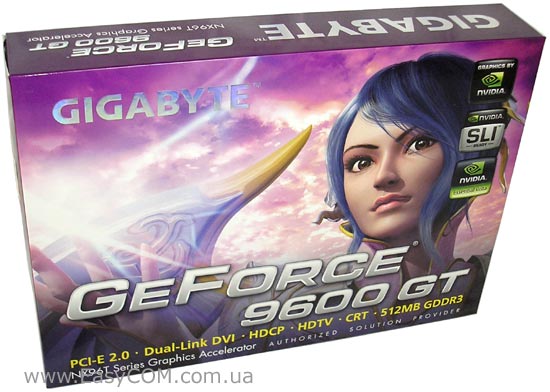
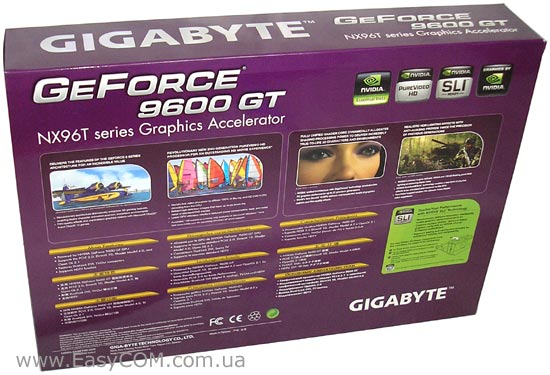
The video card GV-NX96T512H gets to the buyer in a double cardboard box of medium size. The packaging is made in a corporate style and quite informative, although without specifying many exact characteristics (although this defect is compensated in the user manual).
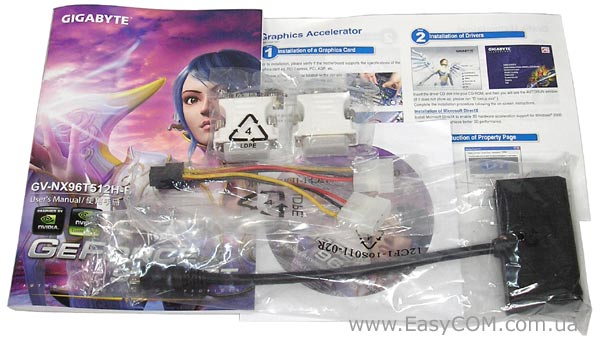
The scope of supply, we can say, includes only the most necessary:
- Power adapter from peripheral connectors to 6-pin PCI Express;
- 2 adapters with VGA to DVI;
- Combined component-wise S-Video and HDTV-Out;
- Quick installation guide for the video card, plus an illustrated poster;
- CD-ROM with drivers and utilities.

The user's guide was quite informative, although to some extent generalized. It indicates the minimum system requirements (from 128 MB of RAM and a 450 W power unit), the assignment of the outputs of the video card and the TV adapter, as well as explanations on the process of installing the video card into the chassis and settings software. Interestingly, for the SLI-configuration the manufacturer suggests using a power supply from 1000 W.

As already noted above, the video card has a completely standard design, which is easily determined by the appearance of the cooling system, which covers the entire front part.

From under the cooler casing, only the 6-pin connector supplementary feeding, located parallel to the plane of the printed circuit board. But, since the size of the map is not very large, this arrangement of the connector will not cause problems, even in fairly compact cases.
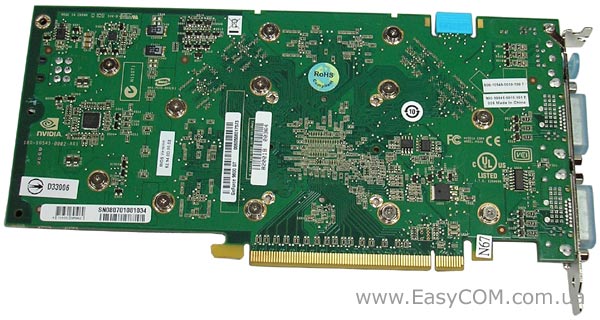
![]()
The printed circuit board itself is completely filled with elements, i.e. It implements all the functions and nodes that were originally built. At the same time, please note that textolite does not presume the installation of HDMI or DisplayPort outputs, although the latter is one of the key features of the series.

But through the adapters, the new interfaces should work, because the top of the card has an input SPDIF, which is designed to add multi-channel audio, processed by a sound card, to video data.

It remains only to voice the standard set of interface connectors: two DVI, convertible to VGA, HDMI and DisplayPort using adapters, and one universal TV output, converted via an adapter into S-Video and component HDTV.
![]()
Now let's talk about the "drain" cooling system. Its positive properties are sufficient efficiency at low noise level and relative compactness, because it only takes one slot. This combination of properties is achieved by using three flattened copper heat pipes to quickly remove energy, and to dissipate the heat of an aluminum radiator that is blown through by a turbine. Through the holes behind the turbine air gets to the circuit board itself. But there is a drawback in this design - the heated air remains in the case, and it is blown out under the video card and will very likely be re-captured for cooling. Therefore, even at nominal frequencies, the graphics processor warmed up to 68 ° C, but the turbine was only spinning at 54%, and the cooler continued to work quietly.
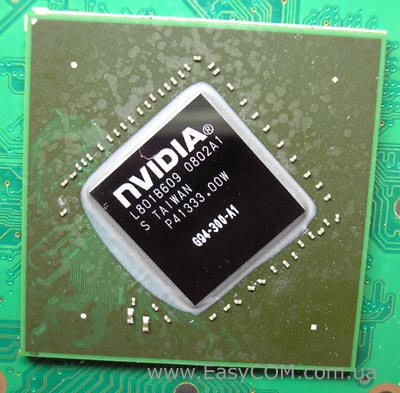

The NVIDIA GeForce 9600 GT graphics processor (G94-300 or D9P) has a crystal that is not covered by a heat spreading cover, deployed 45 ° to the substrate, which is done to simplify wiring. In its arsenal, this GPU has 64 unified processors, 32 texture units and 16 ROPs. GeForce operates at frequencies of 650/1625 MHz for raster and shader units, respectively. To exchange data with video memory, a 256-bit bus is used.
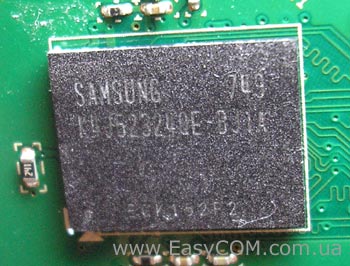
The video memory itself is recruited with eight GDDR3 chips Samsung K4J52324QE-BJ1A, which have a response time of 1.0 ns and are designed to work with an effective frequency of 2000 MHz DDR, but work on the video card a little slower, at the recommended frequency of 1800 MHz. Thus, there is a hope with the help of dispersal to run them at the nominal frequency, and if you are lucky, it will be faster.

Testing

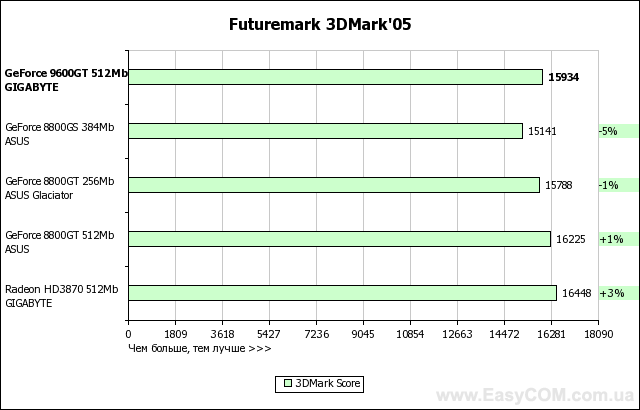

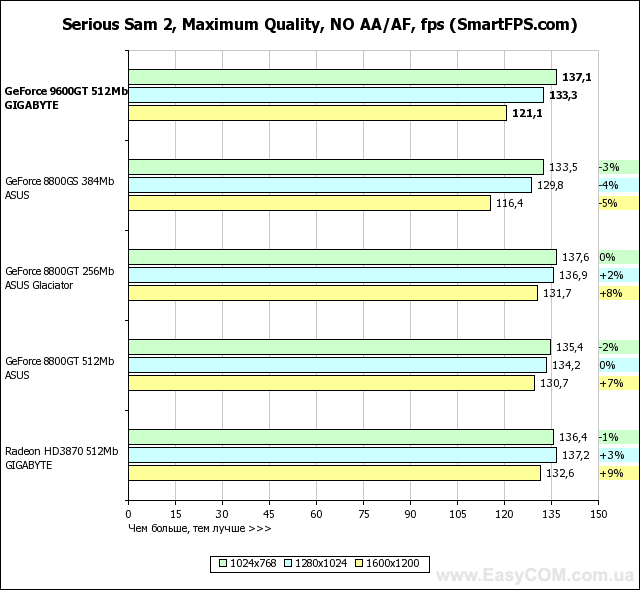





In terms of the performance level, the solutions on the NVIDIA GeForce GPU justify both their recommended price and positioning, in most tasks, reaching the level of the Radeon HD3870, and sometimes even exceeding. In this case, the strongly "stripped down" G92 in the face of the GeForce 8800GS, despite the greater number of pipelines, is defeated. And even 256-megabyte version of GeForce 8800GT in very demanding to the amount of video memory applications is slower. Given the level of performance that is achieved thanks to a well-balanced architecture, GeForce video cards have all chances to become successful hits, especially when the price drops to the level offered by the developer.
Overclocking
The latest version of the RivaTuner utility works remarkably with GeForce and makes it easy to overclock them. We managed to overclock this graphics processor to 780/1950 MHz for the raster and shader domains, respectively, and the video memory was able to significantly exceed the nominal value and steadily worked at the frequency of 2240 MHz. Thus, overclocking GPU was 20%, and on video memory - 24.4%.

With this acceleration of the graphics processor and video memory, you can expect a noticeable increase in performance:
|
Test package |
Standard frequencies |
Overclocked graphics card |
Productivity increase,% |
|
| Futuremark 3DMark'05 | ||||
|
Futuremark 3DMark'06 |
3DMark Score | |||
| SM2.0 Score | ||||
| HDR / SM3.0 Score | ||||
|
Serious Sam 2, Maximum Quality, NO AA / AF, fps |
1024 × 768 | |||
| 1280 × 1024 | ||||
| 1600 × 1200 | ||||
|
Serious Sam 2, Maximum Quality, AA4x / AF16x, fps |
1024 × 768 | |||
| 1280 × 1024 | ||||
| 1600 × 1200 | ||||
|
Call Of Juarez, Maximum Quality, NO AA / AF, fps |
1024 × 768 | |||
| 1280 × 1024 | ||||
| 1600 × 1200 | ||||
|
Call Of Juarez, Maximum Quality, AA4x / AF16x, fps |
1024 × 768 | |||
| 1280 × 1024 | ||||
| 1600 × 1200 | ||||
|
Prey, Maximum Quality, NO AA / AF, fps |
1024 × 768 | |||
| 1280 × 1024 | ||||
| 1600 × 1200 | ||||
|
Prey, Maximum Quality, AA4x / AF16x, fps |
1024 × 768 | |||
| 1280 × 1024 | ||||
| 1600 × 1200 | ||||
|
Crysis, Maximum Quality, NO AA / AF, fps |
1024 × 768 | |||
| 1280 × 1024 | ||||
| 1600 × 1200 | ||||
|
Crysis, Maximum Quality, AA4x / AF16x, fps |
1024 × 768 | |||
| 1280 × 1024 | ||||
| 1600 × 1200 | ||||
We think that additional "free" 10-20% of the performance will always be a pleasant bonus and will never be superfluous, so we want you to get the same overclocking result or even the best one.
Outcomes
Well, the new series of NVIDIA GeForce GPUs brings us new "standard" characteristics for the mass accelerator. Now 512 MB of video memory and 256-bit access bus to it become an integral part of midle-end video cards. At the same time, the GeForce has more executive units that work at a higher frequency, which provides a noticeable increase in performance, raising it to the level of sufficient modern games. Although, on the other hand, there is nothing revolutionary in the architecture of this GPU, even support for DirectX 10.1 is not implemented.





